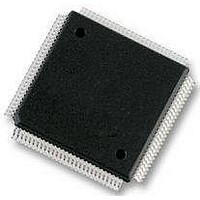MC9S12E128CPV Freescale Semiconductor, MC9S12E128CPV Datasheet - Page 526

MC9S12E128CPV
Manufacturer Part Number
MC9S12E128CPV
Description
Microcontrollers (MCU) 16 Bit 16MHz
Manufacturer
Freescale Semiconductor
Datasheet
1.MC9S12E128CPV.pdf
(606 pages)
Specifications of MC9S12E128CPV
Data Bus Width
16 bit
Program Memory Type
Flash
Program Memory Size
128 KB
Data Ram Size
8 KB
Interface Type
SCI, SPI
Maximum Clock Frequency
25 MHz
Number Of Programmable I/os
92
Number Of Timers
16 bit
Operating Supply Voltage
3.135 V to 5.5 V
Maximum Operating Temperature
+ 85 C
Mounting Style
SMD/SMT
Package / Case
LQFP-112
Minimum Operating Temperature
- 40 C
On-chip Adc
10 bit
On-chip Dac
8 bit, 2 Channel
Lead Free Status / Rohs Status
No RoHS Version Available
Available stocks
Company
Part Number
Manufacturer
Quantity
Price
Company:
Part Number:
MC9S12E128CPVE
Manufacturer:
Freescale Semiconductor
Quantity:
10 000
- Current page: 526 of 606
- Download datasheet (4Mb)
Chapter 18 Multiplexed External Bus Interface (MEBIV3)
18.3.2.8
Read: Anytime (provided this register is in the map).
Write: Each bit has specific write conditions. Please refer to the descriptions of each bit on the following
pages.
Port E serves as general-purpose I/O or as system and bus control signals. The PEAR register is used to
choose between the general-purpose I/O function and the alternate control functions. When an alternate
control function is selected, the associated DDRE bits are overridden.
The reset condition of this register depends on the mode of operation because bus control signals are
needed immediately after reset in some modes. In normal single-chip mode, no external bus control signals
are needed so all of port E is configured for general-purpose I/O. In normal expanded modes, only the E
clock is configured for its alternate bus control function and the other bits of port E are configured for
general-purpose I/O. As the reset vector is located in external memory, the E clock is required for this
access. R/W is only needed by the system when there are external writable resources. If the normal
expanded system needs any other bus control signals, PEAR would need to be written before any access
that needed the additional signals. In special test and emulation modes, IPIPE1, IPIPE0, E, LSTRB, and
R/W are configured out of reset as bus control signals.
This register is not in the on-chip memory map in expanded and special peripheral modes. Therefore, these
accesses will be echoed externally.
526
Normal Expanded Wide
Emulation Expanded
Emulation Expanded
Special Single Chip
Normal Single Chip
Normal Expanded
Special Test
Peripheral
Port E Assignment Register (PEAR)
Narrow
Narrow
Reset
Wide
W
R
NOACCE
0
0
0
1
1
0
0
0
7
Figure 18-12. Port E Assignment Register (PEAR)
= Unimplemented or Reserved
0
0
0
0
0
0
0
0
0
6
MC9S12E128 Data Sheet, Rev. 1.07
PIPOE
0
1
0
1
1
0
0
0
5
NECLK
4
0
0
0
0
0
1
0
0
LSTRE
0
1
0
1
1
0
0
0
3
RDWE
0
1
0
1
1
0
0
0
2
Freescale Semiconductor
0
0
0
0
0
0
0
0
0
1
0
0
0
0
0
0
0
0
0
0
Related parts for MC9S12E128CPV
Image
Part Number
Description
Manufacturer
Datasheet
Request
R
Part Number:
Description:
Manufacturer:
Freescale Semiconductor, Inc
Datasheet:
Part Number:
Description:
Manufacturer:
Freescale Semiconductor, Inc
Datasheet:
Part Number:
Description:
Manufacturer:
Freescale Semiconductor, Inc
Datasheet:
Part Number:
Description:
Manufacturer:
Freescale Semiconductor, Inc
Datasheet:
Part Number:
Description:
Manufacturer:
Freescale Semiconductor, Inc
Datasheet:
Part Number:
Description:
Manufacturer:
Freescale Semiconductor, Inc
Datasheet:
Part Number:
Description:
Manufacturer:
Freescale Semiconductor, Inc
Datasheet:
Part Number:
Description:
Manufacturer:
Freescale Semiconductor, Inc
Datasheet:
Part Number:
Description:
Manufacturer:
Freescale Semiconductor, Inc
Datasheet:
Part Number:
Description:
Manufacturer:
Freescale Semiconductor, Inc
Datasheet:
Part Number:
Description:
Manufacturer:
Freescale Semiconductor, Inc
Datasheet:
Part Number:
Description:
Manufacturer:
Freescale Semiconductor, Inc
Datasheet:
Part Number:
Description:
Manufacturer:
Freescale Semiconductor, Inc
Datasheet:
Part Number:
Description:
Manufacturer:
Freescale Semiconductor, Inc
Datasheet:
Part Number:
Description:
Manufacturer:
Freescale Semiconductor, Inc
Datasheet:











